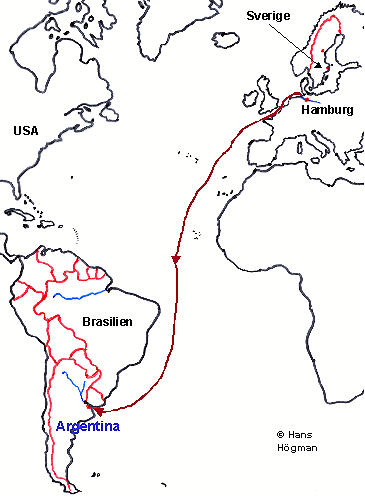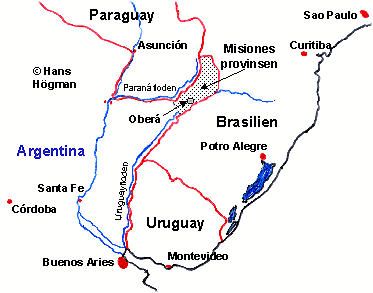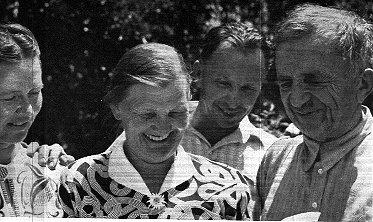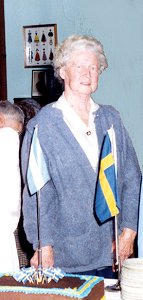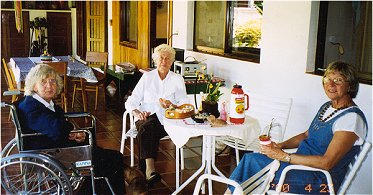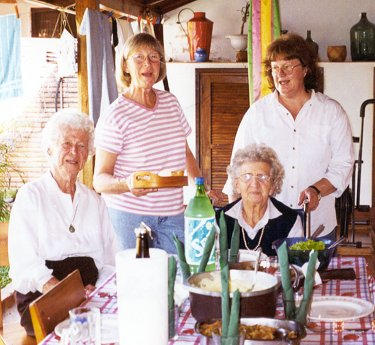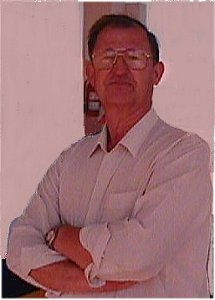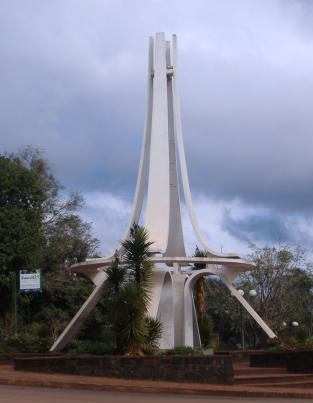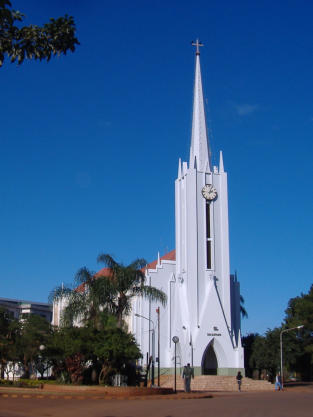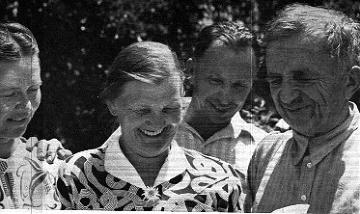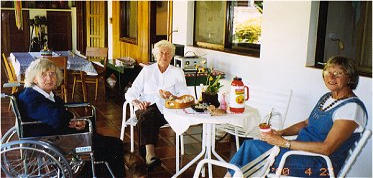

Copyright © Hans Högman 2019-10-05


My Relatives in
Argentina -
The Söderlund
Family
Helena Söderlund (nee
Nordlander)
Helena Söderlund, maiden name Nordlander, is a
sister to my grandmother (my father's mother)
Gerda Högman. Helena emigrates from Sweden to
Argentina with husband and children in July 1927.
The destination harbour for the boat journey is
Buenos Aires. The following text is a résumé of this.
Kristina Helena Nordlander, born June 15, 1883,
dead December 9, 1970. Moves to Viksjö,
Ångermanland province 1904. She marries June 23,
1904 with Erik Söderlund, born October 14, 1879,
dead November 5, 1955. Helena and Erik immigrate
with the children to Argentina in 1927.
They had three children:
1.
Erik (1905–1986)
2.
Emil (1906-1996)
3.
Sylvia Helena (1917-2004 )
All children were born in Viksjö parish (Y), Sweden.
Accompanying the Söderlund family on the journey
to Argentina is the son Erik’s fiancée Sally Elonora
Sundin, born August 5, 1910 in Viksjö,
Ångermanland province, dead May 22, 2007 in
Argentina. The couple later marry in July 11, 1936.
Emil emigrates to the USA in February 1927 and
settles down in California. The rest of the family
emigrates to Argentina in July 1927. It was most
common at the time to travel to Argentina via Brazil,
but the Söderlund family went directly to Argentina.
They went by ship from Hamburg, Germany to
Buenos Aires.
The family settles down in the Misiones district, near
the city Oberá. Misiones is located in the northeast
corner of Argentina, near the Brazilian border.
In the Oberá area there was (is) a Swedish colony
where most Swedes originate from the Norrland
region in Sweden.
The image shows
Sarmiento Avenue,
Oberá, 2005. The church
in the background is the
Cathedral of St. Anthony
of Padua (Roman
Catholic). Wikipedia.
In the Oberá area the family bought 104 hectare of
land, mostly tropical forest, and after a while
another 4400 hectare of land. Here they start a
plantation where they above all grow yerba, a
smaller tree which leaves are harvested and dried.
The leaves are then used to brew maté, Argentina's
national drink (a kind of tea). A plantation is called
charca in Argentina.
Two Swedish princes, Prince Wilhelm and Prince
Lennart does at the end of the 1940’s a journey to
Argentina where they visit several Swedish
descendants. The result of their journey is later
published in the book "Röda Jordens Svenskar"
(Nordstedts förlag, 1948).
The following quotation is from this book:
The owners name is Erik Söderlund, a confident person
from Ångermanland province in Sweden. He greets us
at the doorstep of his spacious house - it is like coming
to a well off freeholder in Östergötland province,
Sweden. Tanned, genial and with a kind look from the
gray eyes he sends out authority, being conscious about
coming good crops from a rational managed charca.
What he does not know about this business is not
worth knowing.
We make a tour of the house together with Mrs.
Söderlund in the homely but well-run home, built from
steady cedar wood planks. The furnishing reminds of
Sweden. Later it is the son Erik’s turn to guide us
through the plantation.
Descendant chart, Helena Söderlund.
The Swedish Imigration to South
America
There was a peak of immigrants to South America in
1891 which was followed by another peak in 1909.
The destination was Brazil. The immigration to
Brazil began as early as 1868. Between 1868 and
1871 about 10.000 people annually immigrated to
the Rio Grande do Sul province in Brazil.
Brazil had an immigration office in Malmö City,
south of Sweden, and carried out an active policy to
get people to immigrate to Brazil. Everyone
interested in immigrating to Brazil were offered to
buy land slots of 25 hectares on easy terms with a 5-
years long installment but also a free passage. The
immigrants were also granted bank loans for
houses, tools and roads.
A free passage attracted the ones that could not
afford to buy tickets for a journey to the USA. All
immigration to South America from Europe went
from Hamburg, Germany. There was a great
demand of both plantation workers and sawmill
laborers in Brazil. So, not all of the immigrants went
there to become settlers.
Most immigrants arrived in Rio de Janeiro, Brazil.
Most settles then continued to Porto Alegre. From
here they traveled by train inland as far as they
could. From the end station they had to travel by
oxcarts. The journey went to the Uruguay River were
they made the last part of the journey by canoes on
the river to their land slots in the middle of the
tropical forest.
It took a while before the Swedes could start the
cultivation. First, they had clear the undergrowth,
then cut down the trees. When the trees had dried
up, they burnt the braches and twigs. Then they
were ready to sow the seeds.
However, there was a completely different situation
to cultivate in the middle of the tropical forests of
Brazil compared to Sweden. Some of the Swedish
immigrants had no experience at all in farm work.
The Swedes were lacking in practice of cultivating
the crops that were used in Brazil, which moth was
best for sowing, the subtropical climate where the
seasons were different from Sweden. The life was
very rough and at moments hopeless. Diseases like
the yellow fever and dysentery were a great
problem. They had problem with drought and
swarms of locusts often destroyed the crops.
Besides that the Uruguay River flooded now and
then.
The Swedish colony was hit by a disaster in October
1911 when the Uruguay River had a severe flooding
which destroyed crops, houses, killed cattle, etc. The
settlers then had to write a letter to the Swedish
Government and ask for help.
About 3,500 Swedes immigrated to Brazil between
the years 1890 and 1913. Alone during the period
1909 to 1911 2,500 Swedes immigrated.
About 900 of these returned to Sweden, mostly
between 1911 and 1913.
The Swedish immigration to Brazil between the
years 1909 to 1911 was referred to as “the caravan of
death” since about 20% died, mostly children.
To Argentina
In order to get better living conditions than they had
in the tropical forests of Brazil many Swedes crossed
the border to Argentina and Misiones province.
Misiones is located between the Paraná River and
the Uruguay River and is to a large extent covered in
forests. The name Misiones can be derived back to
the Jesuit missions founded during the 17th and
18th centuries.
The first Swedes arrived in Misiones in 1902. They first
settled down at Bonpland by the San Javier River
about 15 km on the Argentinean side of the
Brazilian border.
To find better soil for cultivation they moved
another 40 km into the rain forest until they found
good soil, the famous red soil. This soil was perfect
for the yerba mate trees. There was a smaller colony
at this place in 1913 called Yerbal Viejo.
At this point the Argentinean Government had much
interest in increasing the yerba maté cultivation in
Misiones province so the Swedes were now able to
buy land or allotments to a very favorable price and
therefore started yerba plantations. The road to this
place was named Picada Suecia (the Swedish path)
and is still called so.
An increasing number of Swedes flocked to the area,
an influx that continued until the 1940’s. Here they
again had to begin clearing land, burn twigs and set
plants.
The plants they grow beside yerba were maize,
beans, manioc and tobacco. However, it took a few
years before the yerba mate were ready to be
harvested.
The Swedish colony was named Villa Svea. The
Swedes lived on their chacras, plantations. The term
chacra is also a square measure of 25 hectares.
The first dwelling houses were only huts and sheds.
However, once they had cared about the most
urgent needs they started to build proper wooden
houses. When the times got better they built stone
houses which lasted better in this climate.
The Scandinavian Society Svea was founded in
1915. The first Swedish congregation, Olaus Petri,
was founded a couple of years later. The church
services were held on Svea’s premises. In 1917 Svea
got the permission to create a cemetery, The
Swedish Churchyard, and in 1918 the congregation
was legally and formally organized. The
congregation got its first permanent parish minister
in 1942 when pastor Janulf was employed. The
parish church, Olaus Petri, was inaugurated in 1956,
which is located in the central parts of the town
Oberá. The sermons were held in Swedish until 1973
when the Swedish parish minister Sven Arne Flodell
left the ministry. However, a couple of times per
year you still can listen to sermons in Swedish in the
church when a Swedish spoken pastor comes from
Sao Paolo in Brazil to perform the sermons.
A Swedish school was founded in 1922. The lessons
were held in Swedish until 1952 when the school
was closed. There were 927 Swedes living in the
Oberá area in the 1940’s.
The Swedish community Villa Svea was renamed
to Oberá in 1928 when the new town was founded.
Oberá was at the time the largest Swedish colony
in South America. Many names on the town map
still remind of the Swedish times.
Misiones province capital, Posadas, is located about
100 km from Oberá. The city has 141,000
inhabitants (1998) and is located by the Paraná
River. Posadas is an important harbor and a center
for the cultivating of yerba maté, tea and tobacco.
Yerba - The Green Gold
The yerba maté plant (holly - Ilex paraguariensis) is
a shrub or small tree growing up to 15 meters tall.
The leaves are evergreen and 7–11 cm long and
3–5.5 cm wide, with a serrated margin. It grows wild
in Misiones and became the most important crop
that was cultivated.
The leaves (and sometimes also the twigs) of the
yerba shrub are used to make maté, a kind of
bitter tea but also ordinary tea. The people in
adjacent countries like Uruguay, Brazil and Paraguay
are also having the Yerba maté to drink.
You drink yerba maté out of special cups with a
spout (a metal straw called bombilla). The cups look
like large tobacco pipes or hollowed gourds and are
called maté cups or yerba maté gourds. The dried
leaves are placed in the cup, then hot water is
poured over it. Some people also add sugar to it.
The flavor of brewed yerba maté is strongly vegetal,
herbal, and grassy, reminiscent of some varieties of
green tea.
When the maté is brewed you pass the cup around.
Just like coffee and tobacco, yerba mate is addictive.
It was very profitable to cultivate the yerba maté
during the 1930’s and 1940’s. However, in the
middle of the 1940’s the Argentinean Government
decided that all exports were to be handled by the
State. Thereby the State got a monopoly on all
exports why the cultivators now had to sell their
yerba mate directly to the State. The price was set
by the State who could then buy cheap and sell it
with a much higher price. The profit went to the
public treasury and was supposed to finance
different social reforms.
The cultivators had to wait a long time for payment
of the crops which reduced their possibilities of
running the yerba mate plantations.
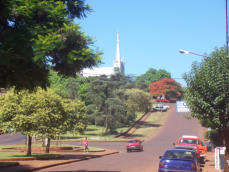
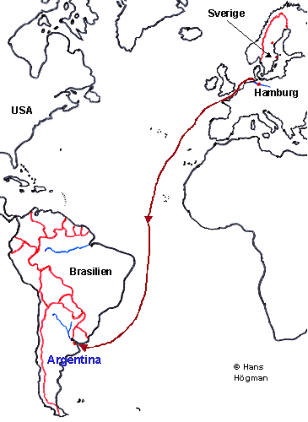
Kartor / Maps
Söderlunds resa från Europa / The Söderlund
family's journey from Europe.
Kartan nedan visar Oberá i Misiones provinsen som
ligger i det nordöstra hörnet av Argentina, nära den
brasilianska gränsen.
The map below is showing Oberá in the province of
Misiones at the northeast corner of Argentina, near
the Brazilian border.
Fotografier / Photos
Helena Söderlund, med familj. På bilden står
Helena i mitten med maken Erik Söderlund till
höger. Mellan dem står sonen Erik och längst till
vänster sonen Eriks hustru Sally (född Sundin).
Mrs. Helena Söderlund, with her family. Mrs
Söderlund is in the middle of the picture and her
husband Erik Söderlund to her right. Between them
are their son Erik and to the far left the son Erik's
wife Sally (maiden name Sundin).
Sally Söderlund, midsommarfirande 1990.
Sally Söderlund, midsummer celebration in 1990
Från vänster, Sylvia Dinesen-Jensen (f. Söderlund
och svägerska med Sally), Sally Söderlund och Sallys
dotter Maj-Britt Keenan, påsken 2000.
From left, Sylvia Dinesen-Jensen (maiden name
Söderlund and sister-in-law to Sally), Sally
Söderlund and Sally's daughter Maj-Britt Keenan,
Easter 2000.
Från vänster, Sally Söderlund och Sallys dotter Maj-
Britt Keenan, Sallys dotter Inger Salazar och
sittande Sylvia Dinesen-Jensen (f. Söderlund och
svägerska med Sally).
(Fotot är taget på Maj-Britts veranda år 2000)
From left: Sally Söderlund and Sallys daughter Maj-
Britt Keenan, Sallys daughter Inger Salazar and in
fron of Inger: Sylvia Dinesen-Jensen (maiden name
Söderlund och sister-in-law to Sally).
(The picture is taken at Maj-Britt's porch in 2000)
Sallys son Jan-Erik Söderlund.
Sally's son Jan-Erik Söderlund.
Monument built for the city's 50th anniversary.
Monumento por el cincuentenario de Oberá.
Free image Wikipedia, 2007.
Cathedral of St. Anthony of Padua (Roman Catholic).
Iglesia de San Antonio, Oberá.
Free image Wikipedia, 2007.







